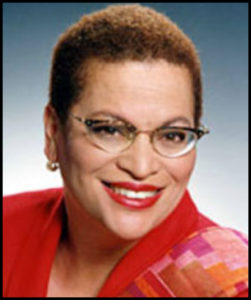We must not normalize poverty and inequity

By Julianne Malveaux
Trice Edney News Wire
When the income and poverty data were released on September 10, the commentary touted the progress that the data reflected. The poverty rate dropped by half a percentage point, down to 11.8 percent. For the first time, the poverty rate is lower than it was in 2007, before the beginning of the Great Recession. But wages only rose significantly among Asian Americans, and the poverty rates, by demographics, were 8.1 percent for Whites, 20.8 percent for African Americans, 17.6 percent for Hispanics, and 10.1 percent for Asian Americans. When we celebrate the drop in the poverty rate, we normalize the fact that African Americans have a much higher poverty rate than Whites do. In simply acknowledging the poverty rate drop, without focusing on the much higher poverty rate of African Americans, we imply that high African American poverty rates are acceptable. They are not. There should be no discussion of poverty rates without an acknowledgment that economic recovery has been extremely uneven, and the distribution of poverty is uneven as well.
It is important to note that if we bemoan high poverty rates, we must acknowledge the progress that comes with lower ones. Things are indeed “better” at the microeconomic level, and better in the aggregate. “Better” for who, we might ask. When we talk about poverty prevention, it is essential to acknowledge that some communities need more help than others do, which is why we should consider targeted programs. Unfortunately, too many assert that we can’t have “Black” programs in a multicultural society. But if Black people experience more poverty, they need more help.
While the poverty rate dropped the proportion of people without health insurance or access to healthcare rose. In 2017, 7.9 percent of all people had no health insurance. By 2018, in just one year, the number jumped to 8.5 percent. At least 27.5 million Americans have no health insurance. That number is deceptive because many who have health insurance cannot afford their copayments and so only visit medical professionals when their situation is dire. While the health data must be nuanced to reveal that the situation is worse than the numbers suggest, the simple increase in the number of folks without health insurance is alarming. If some legislators have their way, even more people will lack access to health insurance, and with the stagnant incomes revealed from the income and poverty data, increasing numbers will be unable to manage their copayments.
Similarly, celebrations about the historic low in the Black unemployment rate tend to normalize the fact that Black people experience proportionately more unemployment than others. When the unemployment rate numbers were released on the first Friday of September, the overall rate was 3.7 percent; while the overall rate for Black folks was 5.5 percent, and 4.4 percent for Black women. While acknowledging this historic low, it is essential to note that the overall Black rate remains twice as high as the White rate. Bragging about the lower rate without acknowledging the unemployment rate gap suggests that Black folks are supposed to have higher unemployment rates than others.
There are lots of problems with the unemployment rate, especially around participate rates that suggest that some are dropping out of the labor force. The unemployment rate data, just like the income and poverty data, also show stagnant wages. Too many are working, but not making a living wage, as the poverty data suggest. The minimum wage has not increased in a decade, and while many cities and states have higher minimum wages, the majority do not. The South, particularly, has been resistant to increasing wages. The South is also the region of the country with the highest poverty rate.
Our nation’s policy conversation too often normalizes African American economic disadvantage. When an 11.8 percent poverty rate is reported, and the Black unemployment rate is not, it implies that the 20.8 percent rate (one in five Black people) is not a matter of concern. When a 5.5 percent “historic low” unemployment rate is reported, but the unemployment rate gap is not, it implies that there is supposed to be an unemployment rate gap and Black people are supposed to have higher unemployment rates than Whites.
We cannot normalize inequality by only partly reporting on reality. Even as we report on economic progress, we must also report on the uneven ways growth affects Black communities.
Julianne Malveaux is an author and economist. Her latest project MALVEAUX! On UDCTV is available on youtube.com. For booking, wholesale inquiries or for more info visit www.juliannemalveaux.com







